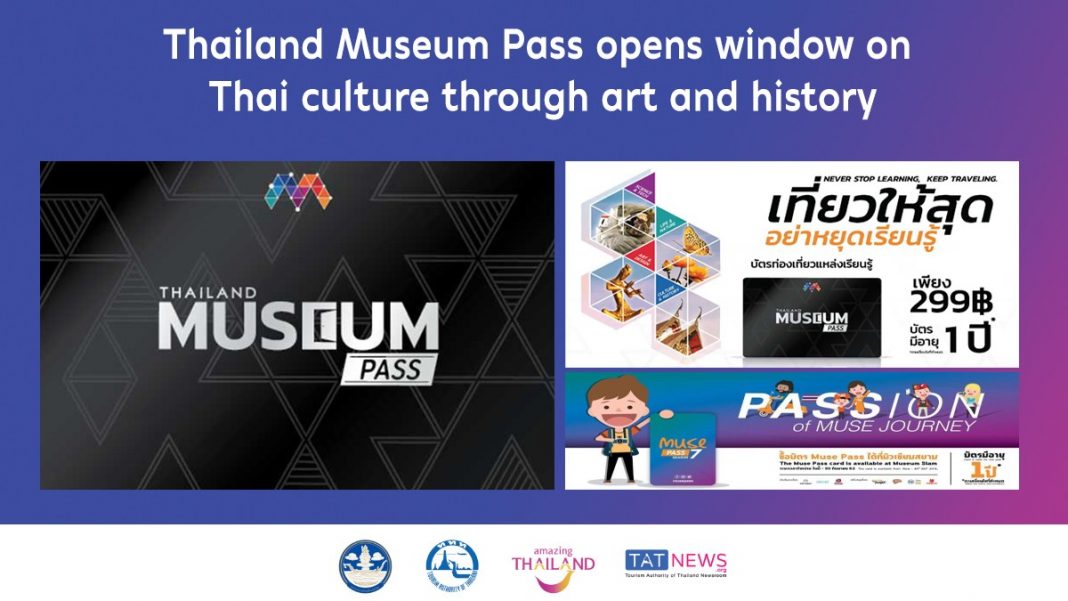Bangkok, 22 March, 2021 – Thailand is rightfully known for its world-famous Thai food, stunning temples, beautiful white sandy beaches, and aquamarine seas. And now its wide-ranging museum landscape has surprisingly become another can’t-miss attraction in its own right with a burgeoning contemporary art scene along with some quirky niche exhibits, complementing a wealth of cultural and historical museum attractions.
All of this makes the Thailand Museum Pass, or Muse Pass, an essential addition to any visitor’s travel portfolio. No longer relegated to just escaping the rain or sweltering sun, it is an economical way to visit 64 museums and multiple learning centres across Thailand.
The Thailand Museum Pass costs 299 Baht and offers visitors entry to museums around the country for one year.
From traditional Thai homes preserved in time to national museums, contemporary galleries, plus educational museums and children’s attractions, Thailand has something for every kind of connoisseur. It affords visitors the opportunity to discover Thailand’s rich history, ancient cultures, and far more through its art, while providing value for money by lowering the price of admission.
In addition to Museum Siam, other attractions in Bangkok covered by the pass include Rattanakosin Exhibition Hall, the Queen’s Gallery, Museum at Wat Traimit, Phayathai Palace, Siam Serpentarium, the Golden Teak Museum, and the Coin Museum Thailand to name just a few.
Others like the Suan Pakkad Palace, a group of eight traditional teak wood Thai houses built centuries ago in Chiang Mai and transported to Bangkok, or the Jim Thompson House and Museum with six traditional teak homes in the middle of the city, provide historical examples of iconic Thai architecture juxtaposed with lush tropical landscaping.
While the Tooney Toy Museum in Nonthaburi is a top children’s attraction and has an impressive collection of over 100,000 toys from all over the world. There’s also a small cafe that sells strong coffee plus souvenirs for customers who might want to start their own toy collection.
The National Aviation Museum of the Royal Thai Air Force is also popular with kids, as it collects, restores, and preserves air force items of different periods, including equipment and aircraft dating from the dawn of Thai aviation up to the present time. Located behind the domestic terminal of Don Mueang International Airport, the Museum is small in size but large in quality of the exhibits on display, including rare aircraft; some that are the last known examples in existence worldwide.
For those heading a little further afield, the Muse Pass can also take visitors to Ripley’s Believe It or Not! in Pattaya, Chon Buri. The Museum features a collection of oddities from all over the world and the chance to discover over 350 amazing things. Also in Chon Buri is the Space Inspirium, Thailand’s first space museum and learning centre that provides an educational opportunity to young and old alike via the museum’s well-designed interactive platform.
For those visitors heading to Lop Buri, the Sap Champa Museum exhibits prehistoric, Indian-influenced artefacts from the city of Sap Champa, which dates back to over 3,000 years ago.
Even further away still is the Phuket Thaihua Museum that documents the island’s vibrant history from different perspectives, including its rich Phuket-China connection. While marine biology lovers should check out the Phuket Aquarium, which highlights Thailand’s rich biodiversity and the creatures from the country’s lakes, rivers and seas hailing from a variety of habitats including mountain streams, mangrove forests, and coral reefs.
In Thailand’s northern region, visitors are spoilt for choice with the Dhanabadee Ceramic Museum in Lampang and the Ja Thawee Folk Museum in Phitsanulok offering insight to real-life local Thai culture and history.
In Chiang Mai, the MAIIAM Contemporary Art Museum is a small, modern museum exhibiting works of contemporary artists from Thailand and from other Asian countries. While the Royal Park Rajapruek, also in Chiang Mai, was built to commemorate the 60th anniversary of His Majesty King Bhumibol Adulyadej the Great’s accession to the throne.
In neighbouring Chiang Rai both the Mae Fah Luang Arboreum and Mae Fah Luang Garden are worthy of an afternoon out or half-day tour. Next to the garden is the Hall of Inspiration that tells the story of the Thai Royal Family and how they inspired other Thais in the service of their country.
For more information on the Thailand Museum Pass, visit: www.museumthailand.com/en/musepass.
*Due to the current COVID-19 outbreak, international travel is discouraged at the moment. However, this article is meant to serve as an inspiration for future trips to Thailand once the pandemic has come to an end.
The post Thailand Museum Pass opens window on Thai culture through art and history appeared first on TAT Newsroom.



